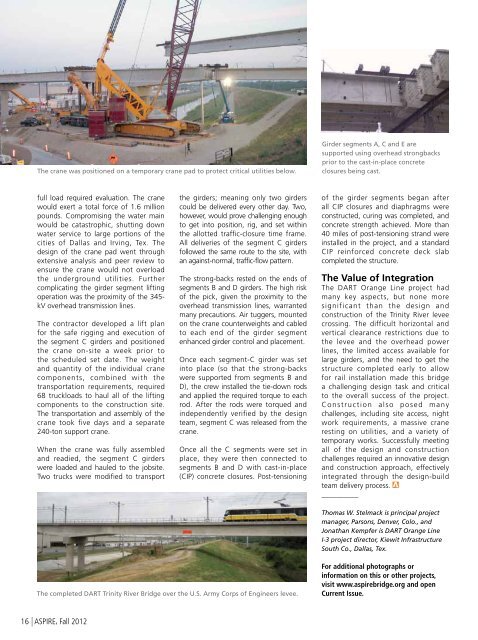ASPIRE Fall 2012 - Aspire - The Concrete Bridge Magazine
ASPIRE Fall 2012 - Aspire - The Concrete Bridge Magazine
ASPIRE Fall 2012 - Aspire - The Concrete Bridge Magazine
You also want an ePaper? Increase the reach of your titles
YUMPU automatically turns print PDFs into web optimized ePapers that Google loves.
<strong>The</strong> crane was positioned on a temporary crane pad to protect critical utilities below.<br />
Girder segments A, C and E are<br />
supported using overhead strongbacks<br />
prior to the cast-in-place concrete<br />
closures being cast.<br />
full load required evaluation. <strong>The</strong> crane<br />
would exert a total force of 1.6 million<br />
pounds. Compromising the water main<br />
would be catastrophic, shutting down<br />
water service to large portions of the<br />
cities of Dallas and Irving, Tex. <strong>The</strong><br />
design of the crane pad went through<br />
extensive analysis and peer review to<br />
ensure the crane would not overload<br />
the underground utilities. Further<br />
complicating the girder segment lifting<br />
operation was the proximity of the 345-<br />
kV overhead transmission lines.<br />
<strong>The</strong> contractor developed a lift plan<br />
for the safe rigging and execution of<br />
the segment C girders and positioned<br />
the crane on-site a week prior to<br />
the scheduled set date. <strong>The</strong> weight<br />
and quantity of the individual crane<br />
components, combined with the<br />
transportation requirements, required<br />
68 truckloads to haul all of the lifting<br />
components to the construction site.<br />
<strong>The</strong> transportation and assembly of the<br />
crane took five days and a separate<br />
240-ton support crane.<br />
When the crane was fully assembled<br />
and readied, the segment C girders<br />
were loaded and hauled to the jobsite.<br />
Two trucks were modified to transport<br />
the girders; meaning only two girders<br />
could be delivered every other day. Two,<br />
however, would prove challenging enough<br />
to get into position, rig, and set within<br />
the allotted traffic-closure time frame.<br />
All deliveries of the segment C girders<br />
followed the same route to the site, with<br />
an against-normal, traffic-flow pattern.<br />
<strong>The</strong> strong-backs rested on the ends of<br />
segments B and D girders. <strong>The</strong> high risk<br />
of the pick, given the proximity to the<br />
overhead transmission lines, warranted<br />
many precautions. Air tuggers, mounted<br />
on the crane counterweights and cabled<br />
to each end of the girder segment<br />
enhanced girder control and placement.<br />
Once each segment-C girder was set<br />
into place (so that the strong-backs<br />
were supported from segments B and<br />
D), the crew installed the tie-down rods<br />
and applied the required torque to each<br />
rod. After the rods were torqued and<br />
independently verified by the design<br />
team, segment C was released from the<br />
crane.<br />
Once all the C segments were set in<br />
place, they were then connected to<br />
segments B and D with cast-in-place<br />
(CIP) concrete closures. Post-tensioning<br />
of the girder segments began after<br />
all CIP closures and diaphragms were<br />
constructed, curing was completed, and<br />
concrete strength achieved. More than<br />
40 miles of post-tensioning strand were<br />
installed in the project, and a standard<br />
CIP reinforced concrete deck slab<br />
completed the structure.<br />
<strong>The</strong> Value of Integration<br />
<strong>The</strong> DART Orange Line project had<br />
many key aspects, but none more<br />
significant than the design and<br />
construction of the Trinity River levee<br />
crossing. <strong>The</strong> difficult horizontal and<br />
vertical clearance restrictions due to<br />
the levee and the overhead power<br />
lines, the limited access available for<br />
large girders, and the need to get the<br />
structure completed early to allow<br />
for rail installation made this bridge<br />
a challenging design task and critical<br />
to the overall success of the project.<br />
Construction also posed many<br />
challenges, including site access, night<br />
work requirements, a massive crane<br />
resting on utilities, and a variety of<br />
temporary works. Successfully meeting<br />
all of the design and construction<br />
challenges required an innovative design<br />
and construction approach, effectively<br />
integrated through the design-build<br />
team delivery process.<br />
__________<br />
Thomas W. Stelmack is principal project<br />
manager, Parsons, Denver, Colo., and<br />
Jonathan Kempfer is DART Orange Line<br />
I-3 project director, Kiewit Infrastructure<br />
South Co., Dallas, Tex.<br />
<strong>The</strong> completed DART Trinity River <strong>Bridge</strong> over the U.S. Army Corps of Engineers levee.<br />
For additional photographs or<br />
information on this or other projects,<br />
visit www.aspirebridge.org and open<br />
Current Issue.<br />
16 | <strong>ASPIRE</strong>, <strong>Fall</strong> <strong>2012</strong>

















